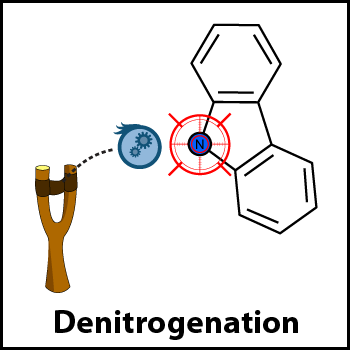Team:Calgary/Project/OSCAR/Upgrading
From 2012.igem.org
[http://www.example.com link title]


Hello! iGEM Calgary's wiki functions best with Javascript enabled, especially for mobile devices. We recommend that you enable Javascript on your device for the best wiki-viewing experience. Thanks!
Upgrading our Product
While we have been able to show that we can convert toxins such as naphthenic acids into useful hydrocarbons there is still a lot of compounds in the tailings that will decrease the value of our product as a fuel. These compounds include sulfur and nitrogen containing heterocyclic atoms such as dibenzothiophene (DBT) and carbazole. Normally these compounds are removed through chemical means, but this requires expensive machinery, extreme pressurs and temperatures, and the addition of organic solvents. By using synthetic biology to do this in a simple bioreactor we can save the energy that is required to produce these conditions and reduce the cost of the expensive processes.
Why Use Synthetic Biology? Why Not Chemical Methods?
The most widely used chemical method for removing nitrogen from fuel sources is called hydrodenitrogenation (HDN). This process is not completely efficient, as only 77% of nitrogen containing compounds are actually removed (Zeuthen et al. 2001). It also requires harsh conditions, for example temperatures upwards of 350° C and pressures up to 30 Bar. This is mostly because the nitrogen atoms in the ring must be hydrogenated before the carbon-nitrogen bond can be cleaved because this (Katzer & Sivasubramanian, 1979). The input of molybdenum based chemical catalysts required for this reaction is also very costly and can produce toxic by-products of its own (Zhu et al. 2008). Desulfurization has similar problems. Hydrodesulfurization for example, requires high temperature and pressure and also releases the sulfur in the form of hydrogen sulfide gas, a toxic compound which is then converted to elemental sulfur or sulfuric acid.
In contrast to this, microbes have been found capable of harvesting both sulfur and nitrogen out of hydrocarbons under physiological conditions, making them a much more environmentally sound and economic approach to carry out on an industrial scale. Synthetic biology can potentially offer a new avenue to address these problems, with much more potential for innovation and new ideas.
We took two main approaches for upgrading our hydrocarbons. The first method focused on reducing the sulfur content of the product through the action of desulfurization. This would prevent the production of toxic sulfur gasses when the hydrocarbons are combusted in an engine. Our second approach uses denitrogenation to remove nitrogen containing compounds from the product. This will reduce the emissions of nitrous oxide gasses that are heavily involved in global warming.
Click on OSCAR to learn more about what he can do!


 "
"
